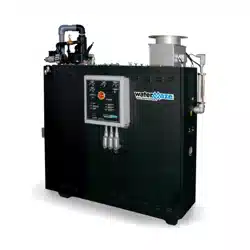Loading ...
Loading ...
Loading ...

WATERMAZE SERIES OPERATOR’S MANUAL
9
WB • 8.913-984.0-N
OPERATING PROCEDURE
First, collect the waste stream. This can be accomplished
with the use of a catch basin, collection pit, sump or any
other process which collects the waste stream in one
location. The collection method should allow for oil and
solids separation. The waste stream must be stored in
an above ground tank to provide a gravity feed situation
to the waste stream pump of the evaporator. The WATER
MAZE air diaphragm pumps are self priming but we do
recommend a positive feed system (see figure 3).
1. A fresh water source is connected to the evaporator
for the initial fill. The evaporator must have a mini-
mum amount of water before it will operate.
2. With the gas line, gas vent, exhaust vent and elec-
trical connected and main disconnect turned on,
push the reset button F1/RST on the timer. NOTE:
Whenever the power to the evaporator goes out, the
reset button F1/RST on the timer must be pushed.
3. Turn the blower switch to the automatic position. This
will engage the blower which will push the water out
of the sparger tube. This causes the water level to
rise slightly in the liquid level float assembly. If the
low water light is still illuminated, attach a garden
hose to the back of the machine and fill the tank
until the light goes out. Now it is time to turn on the
burner.
4. Turn the burner switch to the on position. The system
now goes through the interlocks, 1) high/low gas
pressure; 2) air pressure; 3) closed gas solenoid,
4) low water, bottom setpoint on the 3 point level
control rod. Now a purge cycle will purge the sparger
tube with air for 15 seconds to insure that there is no
gas in the sparger tube. The burner then attempts
to ignite the soft start pilot flame. If there is not an
ignition, the UV scanner shuts the system down and
the start up sequence must be started over.
5. Once the burner ignites, the waste pump switch
can be turned on to introduce wastewater into the
evaporator. This will add wastewater to the system
through the back of the tank.
NOTE: The heat from the burner goes through the
sparger tube and out a slot in the bottom of the
sparger tube, and finally, into the surrounding water.
There are five stainless steel screens on a WB-50
and ten on the WB-120, that break down the size
of bubbles (from big to small) which increases the
surface area and transfers virtually 100% of their
heat to the water to increase saturation (screen hole
size is 1/16").
Auto Purge:
The unit will automatically purge the waste stream from
the combustion chamber at a set time depending on
your waste stream. This purged waste stream must
be sent to an appropriate discharge holding tank and
not back to the feed or inlet holding tank going to
WATER MAZE.
PRINCIPLES OF OPERATION
The WATER MAZE evaporator is designed to evaporate
wastewater. WATER MAZE uses a unique method of
introducing the wastewater directly into a 2000°F flame.
Using submerged combustion technology, the WATER
MAZE can obtain virtually a 100% heat transfer for a
more efficient and less costly method of evaporation.
In order to understand how this system works and why
it is superior to any other evaporator on the market, it is
important to understand a few aspects of relative humid-
ity, submerged combustion and efficiency ratings of this
type of equipment.
First, relative humidity is called “relative” because the
amount of moisture a given amount of air can hold is
directly related to its temperature. For example, let's say
it's snowing. If you were to take a cubic foot of outside
air at 20° F, with a relative humidity of 100% and bring
this air inside and warm it up to 72°F; the same air would
have the same amount of moisture in it, but would have
a relative humidity of only 15%. The warmer the air is,
the more moisture it can hold. With regard to the WATER
MAZE, this "thirst" or affinity for moisture in hotter air is
especially dramatic at temperatures above 150°F.
Second, it will be of value for you to be familiar with some
basics of water heating and evaporation. All of this type
of equipment will be rated in terms of British thermal
units (BTU's) per hour.
A BTU is the amount of heat necessary to raise one
pound of water one degree Fahrenheit.
Let's say we want to evaporate one pound of water:
In order to get our pound of water from 60°F to 212°F,
we will have to add 152 BTU's to it (212°F minus 60°F).
This is called “sensible” heat.
Once this pound of water reaches 212°F, 970 BTU's must
then be applied to turn it into a pound of steam vapor still
at 212°F. We just want to change it from liquid water to
steam vapor and not raise the temperature at all. This
is called “latent” heat.
Therefore, to get our pound of 60°F water to 212°F
steam took 1122 BTU's.
A gallon of water weighs 8.34 pounds. In order to make
a gallon of water evaporate, we have to subject it to 8.34
lbs. x 1122 BTU's or, 9357 BTU's.
Loading ...
Loading ...
Loading ...
